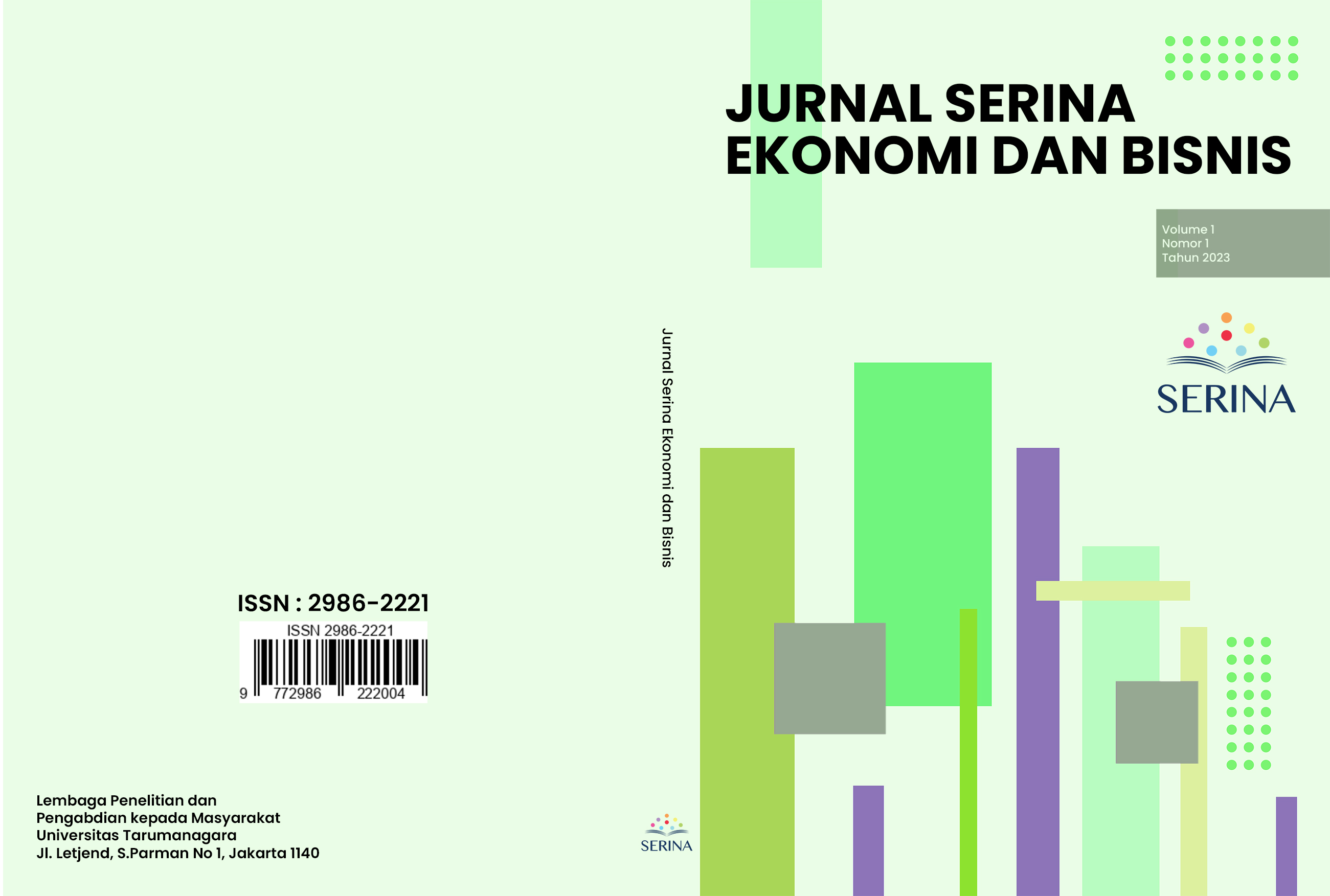PENGARUH EFIKASI DIRI, KREATIVITAS, DAN GAIRAH BERWIRAUSAHA TERHADAP INTENSI BERWIRAUSAHA PADA MAHASISWA
Main Article Content
Abstract
This research was conducted with the aim of knowing whether there is an effect of self-efficacy on entrepreneurial intentions, creativity on entrepreneurial intentions, and entrepreneurial passion on entrepreneurial intentions for students of private universities in West Jakarta. The subjects included in this study were 100 respondents who were private university students in West Jakarta. This study uses a non-probability sampling method. The data analysis used in this study uses Partial Least Square (PLS), which is the SmartPLS 3.3.3 application. The findings of this study indicate that creativity has no effect on entrepreneurial intentions, while self-efficacy and entrepreneurial enthusiasm have an influence on entrepreneurial intentions in private university students in West Jakarta.
Penelitian ini dilakukan dengan tujuan untuk mengetahui apakah terdapat pengaruh efikasi diri terhadap intensi berwirausaha, kreativitas terhadap intensi berwirausaha, dan gairah berwirausaha terhadap intensi berwirausaha bagi Mahasiswa Universitas swasta di Jakarta Barat. Subjek yang terdapat dalam penelitian ini adalah sebanyak 100 responden yang merupakan Mahasiswa Universitas swasta di Jakarta Barat. Penelitian ini menggunakan metode non probability sampling. Analisis data yang digunakan dalam penelitian ini menggunakan adalah Partial Least Square (PLS) yang merupakan aplikasi SmartPLS 3.3.3. Hasil temuan penelitian ini menunjukkan bahwa kreativitas tidak memiliki pengaruh terhadap intensi berwirausaha, sedangkan efikasi diri dan gairah berwirausaha pengaruh terhadap intensi berwirausaha pada mahasiswa universitas swasta di Jakarta Barat.
Article Details
Section

This work is licensed under a Creative Commons Attribution-NonCommercial-ShareAlike 4.0 International License.
References
Abdillah, W. H. (2015). Partial least square (PLS). Penerbit Andi.
Ajzen, I. (1991). The theory of planned behavior. Organizational behavior and human decision processes, 50(2), 179-211.
Arikunto, S. (2013). Prosedur Penelitian: Suatu Pendekatan Praktik. Rineka Cipta.
Baron, R. A., and Ward, T. B. (2004). Expanding entrepreneurial cognition’s toolbox: potential contributions from the field of cognitive science. Entrep. Theory Pract. 28, 553–573.
Bellò, Benedetta Mattana., Veronica., dan Loi, Michela. (2018). The Power Of Peers: A New Look At The Impact Of Creativity, Social Context and Self-efficacy On Entrepreneurial Intentions.
Bignetti, B., Santos, A. C. M. Z., Hansen, P. B., & Henriqson, E. (2021). The influence of entrepreneurial passion and creativity on entrepreneurial intentions. Revista de Administração Mackenzie, 22(2), 1–32.
Biraglia, A., & Kadile, V. (2017). The role of entrepreneurial passion and creativity in developing entrepreneurial intentions: Insights from American homebrewers. Journal of Small Business Management, 55(1), 170–188.
Blegur, A., & Handoyo, S. E. (2020). Pengaruh pendidikan kewirausahaan, efikasi diri dan locus of control terhadap intensi berwirausaha. Jurnal Manajerial Dan Kewirausahaan, 2(1), 51-61.
Cardon, M. S., Wincent, J., Singh, J., & Drnovsek, M. (2009). The nature and experience of entrepreneurial passion. Academy of Management Review, 34(3), 511–532.
Cardon, M.S., Sudek, R., Mitteness, C., (2009). The impact of perceived entrepreneurial passion on angel investing. In: Zacharakis, A.L. (Ed.), Frontiers of Entrepreneurship Research: Proceedings of the Babson College Entrepreneurship Research Conference, 29, Babson College, Wellesley, MA.
Dilla, V.O., dan Umami, N., (2018). Pengaruh Efikasi Diri Dan Kreativitas Terhadap Intensi Berwirausaha Pada Siswa Kelas Xi Smk Negeri 1 Pogalan Tahun Ajaran 2017/2018. Jurnal Pendidikan Ekonomi, 11(2), 80-88.
Doanh, D. C., & Trang, T. V. (2019). The role of structural support in predicting entrepreneurial intention: Insights from Vietnam. Management Science Letters 9, 1783–1798.
Ghozali, H. L. (2011). Aplikasi Analisis Multivariate Dengan Program SPSS. Badan Penerbit Universitas Diponegoro.
Gunawan dan Puspitowati (2019) Pengaruh Self Efficacy Dan Risk Taking Terhadap Intensi Berwirausaha Mahasiswa Universitas Tarumanagara. Jurnal Manajerial Dan Kewirausahaan, 1(3), 438-446.
Hair, J., Black, W., Babin, B., & Anderson, R. (2014). on Multivariate Data Analysis Joseph F. Hair Jr. William. Black Eight Edition.
Hartono, J., dan Puspitowati, I. (2018). Pengaruh Attitude, Subjective Norms Dan Self Efficacy Terhadap Intensi Berwirausaha Pada Mahasiswa Fakultas Ekonomi Universitas Tarumanagara.
Hisrich, Peters. (1998). Entrepreneurship, fourth edition. Mc Graw Hill inc.
Karimi, M. N. (2011). The effects of professional development initiatives on EFL teachers' degree of self efficacy. Australian Journal of Teacher Education, 36(6), 50-62.
Krueger, N., and Brazeal, D. (1994). Entrepreneurial potential and potential entrepreneurs: Entrepreneurship Theory and Practice. 18(1), 91-105.
Liñán, F., & Fayolle, A. (2015). A systematic literature review on entrepreneurial intentions: Citation, thematic analyses, and research agenda. International Entrepreneurship and Management Journal, 11(4), 907–933.
Liñán, F., and Chen, Y. W. (2009). Development and cross-cultural application of a specific instrument to measure entrepreneurial intentions. Entrep. Theory Pract. 33, 593–617.
Malhotra, N. K. (2015). Essentials of Marketing Research, A HandsOn Orientation. Pearson Education Limited, 82-285.
Natalia, C., dan Rodhiah, D. (2019). Pengaruh Kreativitas, Edukasi Dan Efikasi Diri Terhadap Intensi Berwirausaha Dalam Generasi Z, Jurnal Manajerial dan Kewirausahaan, 1(2) , 164-171.
Plucker, J., Beghetto, R., & Dow, G. (2004). Why isn’t creativity more important to educational psychologists? Potentials, pitfalls, and future directions in creativity research. Educational Psychologist, 39, 83-96.
Santos, F., and Linan, F. (2010). Gender differences in entrepreneurial intentions: An international comparison. Working paper.
Santoso, D. A., & Selamat, F. (2019). Pengaruh Dukungan Universitas Dan Sikap Proaktif Terhadap Intensi Kewirausahaan Mahasiswa Di Jakarta. I (3), 401– 410.
Sekaran, U., & Bougie, R. (2016). Research Methods for Business. Ed 7th. Wiley.
Shook, C.L., Bratianu, C. (2008) Entrepreneurial intent in a transitional economy: an application of the theory of plannedbehavior to Romanian students. International Entrepreneurship Management Journal, 6 (3), 231-47.
Siswoyo, H. (2015). Metode SEM untuk Penelitian Manajemen dengan Amos Lisrel PLS. Penerbit PT IPU, Jakarta.
Solso, Robert L., Maclin, Otto H., Maclin, M. Kim berly. (2007). Psikologi Kognitif Edisi Kedelapan. Penerbit Erlangga.
Sugiyono. (2012). Metode Penelitian Kuantitatif Kualitatif dan R&D. Alfabeta.
Sugiyono. (2015). Metode penelitian kombinasi (mixed methods). Alfabeta.
Sugiyono. (2016). Metode Penelitian Kuantitatif, Kualitatif dan R&D. PT Alfabet.
Suharyadi dan Purwanto S.K. (2009). Statistika Untuk Ekonomi dan Keuangan Modern. Salemba Empat.
Yildirim, C., Sumuer, E., Adnan, M and Yildirim, S. (2016). A Growing Fear: Prevalence of Nomophobia among Turkish College Students. Information Development, 32(5), 1322- 1331
Zulkosky. (2009). Self-Efficacy: A Concept Analysis

